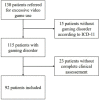Gaming Disorder Seen Through the Prism of Dual Diagnosis: Prevalence and Associated Factors
- PMID: 35873269
- PMCID: PMC9304658
- DOI: 10.3389/fpsyt.2022.821432
Gaming Disorder Seen Through the Prism of Dual Diagnosis: Prevalence and Associated Factors
Abstract
Introduction: Dual diagnosis (DD) is defined as the co-occurrence of at least a psychiatric disorder and at least an addictive disorder. Most studies about DD considered substance use disorders. In 2018, gaming disorder (GD) was recognized as a formal disorder and integrated into the category of addictive disorders in the 11th version of the International Classification of Diseases. Our objectives were to measure DD prevalence among GD patients and to assess factors associated with the presence of DD.
Methods: As part of the EVALuation of behavioral ADDictions (EVALADD) cohort, 92 patients with GD were included in the present study. Psychiatric disorders, including anxiety, mood, and psychotic disorders, were explored with the Mini International Neuropsychiatric Interview (MINI 5.0.0). Probable adult attention-deficit/hyperactivity disorder (ADHD) was screened with the Wender Utah Rating Scale (WURS) in childhood and with the ADHD Self-Report Scale-V1.1 (ASRS) in adulthood. Finally, personality was assessed using the 125-item version of the Temperament and Character Inventory (TCI-125), motives for gaming with the Videogame Motives Questionnaire (VMQ) and attachment styles with the Relationship Scales Questionnaire (RSQ). To measure the prevalence of DD among GD patients, we considered the occurrence of current GD with current anxiety, mood, or psychotic disorders, or with probable current ADHD. We also performed a multivariate analysis to identify independent factors associated with DD.
Results: More than half (55.4%) of GD patients suffered from DD. We found a high prevalence of probable ADHD (38%) and anxiety disorders (29% suffering from generalized anxiety disorder, social, agoraphobia or panic disorder). Four variables were significantly associated with DD: suicidal thoughts [odds ratio (OR) = 6.83, 95% confidence interval (95%CI) (1.66-28.09)], VMQ "coping" scores [OR = 1.18, 95%CI (1.01-1.38)], TCI-125 "harm avoidance" scores [OR = 1.04, 95%CI (1.01-1.07)] and "novelty seeking" scores [OR = 1.03, 95%CI (1.00-1.06)].
Discussion: The prevalence of certain psychiatric disorders among GD patients far exceeded that observed in the general population. Both ADHD and suicidal ideations should particularly be screened among GD patients. Specific interventions targeting personality dimensions associated with DD but also on the management of negative affect should represent new treatment opportunities.
Keywords: addiction; associated factors; dual diagnosis; gaming disorder; risk of suicide.
Copyright © 2022 Barrangou-Poueys-Darlas, Cabelguen, Garrouste, Leboucher, Rocher, Challet-Bouju and Grall-Bronnec.
Conflict of interest statement
The authors declare that the research was conducted in the absence of any commercial or financial relationships that could be construed as a potential conflict of interest.
Figures
Similar articles
-
Attention deficit hyperactivity disorder and gaming disorder: Frequency and associated factors in a clinical sample of patients with Gaming Disorder.J Behav Addict. 2021 Oct 26;10(4):1061-7. doi: 10.1556/2006.2021.00074. Online ahead of print. J Behav Addict. 2021. PMID: 34710057 Free PMC article.
-
Frequency of and Factors Associated with the Presence of a History of Probable Attention-Deficit Hyperactivity Disorder in a Population of Patients with Sex Addiction.Eur Addict Res. 2023;29(3):161-170. doi: 10.1159/000530110. Epub 2023 Apr 21. Eur Addict Res. 2023. PMID: 37088070
-
A case-control study for psychiatric comorbidity and associative factors of gaming disorder and hazardous gaming based on ICD-11 criteria: Cognitive control, emotion regulation, and reinforcement sensitivity.J Behav Addict. 2024 Dec 5;13(4):1014-1027. doi: 10.1556/2006.2024.00066. Print 2024 Dec 30. J Behav Addict. 2024. PMID: 39636323 Free PMC article.
-
[Personality factors in depressive disorders: contribution of the psychobiologic model developed by Cloninger].Encephale. 2002 Jul-Aug;28(4):363-73. Encephale. 2002. PMID: 12232546 Review. French.
-
Psychopathological rating scales for diagnostic use in adults with attention-deficit/hyperactivity disorder (ADHD).Eur Arch Psychiatry Clin Neurosci. 2006 Sep;256 Suppl 1:i3-11. doi: 10.1007/s00406-006-1001-7. Eur Arch Psychiatry Clin Neurosci. 2006. PMID: 16977549 Review.
References
-
- American Psychiatric Association . Diagnostic and Statistical Manual of Mental Disorders. 5th ed. Washington, DC: American Psychiatric Association; (2013).
-
- World Health Organization . ICD-11 Beta Draft – Mortality and Morbidity Statistics. Mental, Behavioural or Neurodevelopmental Disorders. (2018). Available online at: https://icd.who.int/dev11/l-m/en#/http%3a%2f%2fid.who.int%2ficd%2fentity... (accessed March 30, 2021).
-
- Billieux J, Van der Linden M, Achab S, Khazaal Y, Paraskevopoulos L, Zullino D, et al. . Why do you play World of Warcraft? An in-depth exploration of self-reported motivations to play online and in-game behaviours in the virtual world of Azeroth. Comput Hum Behav. (2013) 29:103–9. 10.1016/j.chb.2012.07.021 - DOI
LinkOut - more resources
Full Text Sources
Research Materials



